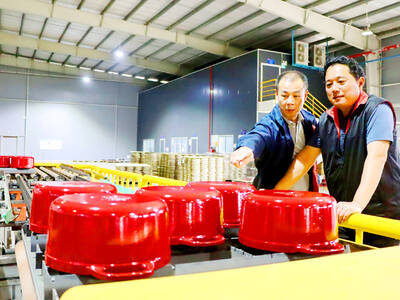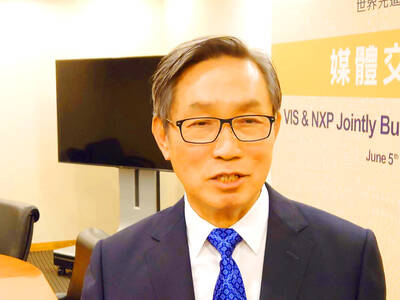Tokyo yesterday approved US$10.7 billion in fresh spending to help boost Japan’s limp economy, just weeks before an election the ruling party is expected to lose.
The ¥880 billion (US$10.7 billion) in spending was more than double a package announced in October as the country gets set for polls that are expected to usher in Japan’s seventh prime minister in six years.
However, the move, which came as official data showed Japan posted a surprise uplift in factory production in October, threatened to trigger vote-buying criticism from opposition lawmakers.

Photo: EPA
The spending will focus on boosting growth in a range of sectors, including healthcare and agriculture, as well as on public works projects following last year’s earthquake and tsunami disaster.
Opinion polls suggest Prime Minister Yoshihiko Noda and his Democratic Party of Japan (DPJ) will be defeated by the country’s main opposition leader Shinzo Abe, who heads the Liberal Democratic Party (LDP).
Abe has vowed to spend heavily on public works and pressure the Bank of Japan into launching aggressive monetary easing measures to boost growth if his party wins the Dec. 16 vote.
The central bank has unveiled two policy easing measures in recent months as its counterparts in the US and Europe launched huge moves to counter slowing growth.
Japan’s economy contracted in the July to September quarter, nudging it toward recession and dousing hopes that the nation had cemented a recovery after last year’s twin disasters, which triggered the worst atomic crisis in a generation.
Masamichi Adachi, a senior economist at JPMorgan Securities, questioned the effectiveness of the latest government stimulus measures.
“While [the package] wouldn’t be a poison, it wouldn’t be a medicine either,” Adachi told reporters.
A glimmer of hope emerged yesterday as official data showed Japan’s factory output rose 1.8 percent in October, the first rise in four months and beating market expectations of a 2.2 percent drop.
Separate figures showed the jobless rate held steady while household spending for the month was better than expected, suggesting a possible improvement in consumer confidence.
The unexpected output jump — and a producers’ survey that forecast a 7.5 output rise this month after a small decline for last month — gave the Tokyo stock market a small boost with the benchmark Nikkei 225 index adding 0.48 percent by the close.
However, the economy ministry doused hopes that the latest data was something to cheer about, saying in a statement that output was on a “downward trend.”
Credit Agricole economist Kazuhiko Ogata cautioned against optimism, saying a sustained recovery would depend on stronger overseas demand for Japanese exports, while producers will have to bring down their built-up inventory.
“A bottom-out of production would be confirmed only after the turn of the year at the earliest,” Ogata said.
Chris Tedder, research analyst at Forex.com in Sydney, said the new figures quelled “some concern of a prolonged slowdown in the world’s third-largest economy.”
However, “overall, the data isn’t enough to turn us away from predicting a recession in Japan this quarter,” he said.
As weak European markets dent demand for Japanese exports, a territorial row over islands in the East China Sea claimed by Tokyo, Taipei and Beijing has also affected the trade balance owing to a consumer boycott of Japanese brands.
Japan’s top three automakers — Toyota, Nissan and Honda — all reported that the row with China has affected sales and profits, with October data on Thursday showing a marked drop output in China, the world’s biggest vehicle market.

TAKING STOCK: A Taiwanese cookware firm in Vietnam urged customers to assess inventory or place orders early so shipments can reach the US while tariffs are paused Taiwanese businesses in Vietnam are exploring alternatives after the White House imposed a 46 percent import duty on Vietnamese goods, following US President Donald Trump’s announcement of “reciprocal” tariffs on the US’ trading partners. Lo Shih-liang (羅世良), chairman of Brico Industry Co (裕茂工業), a Taiwanese company that manufactures cast iron cookware and stove components in Vietnam, said that more than 40 percent of his business was tied to the US market, describing the constant US policy shifts as an emotional roller coaster. “I work during the day and stay up all night watching the news. I’ve been following US news until 3am

Six years ago, LVMH’s billionaire CEO Bernard Arnault and US President Donald Trump cut the blue ribbon on a factory in rural Texas that would make designer handbags for Louis Vuitton, one of the world’s best-known luxury brands. However, since the high-profile opening, the factory has faced a host of problems limiting production, 11 former Louis Vuitton employees said. The site has consistently ranked among the worst-performing for Louis Vuitton globally, “significantly” underperforming other facilities, said three former Louis Vuitton workers and a senior industry source, who cited internal rankings shared with staff. The plant’s problems — which have not

TARIFF CONCERNS: The chipmaker cited global uncertainty from US tariffs and a weakening economic outlook, but said its Singapore expansion remains on track Vanguard International Semiconductor Corp (世界先進), a foundry service provider specializing in producing power management and display driver chips, yesterday withdrew its full-year revenue projection of moderate growth for this year, as escalating US tariff tensions raised uncertainty and concern about a potential economic recession. The Hsinchu-based chipmaker in February said revenues this year would grow mildly from last year based on improving supply chain inventory levels and market demand. At the time, it also anticipated gradual quarter revenue growth. However, the US’ sweeping tariff policy has upended the industry’s supply chains and weakened economic prospects for the world economy, it said. “Now

COLLABORATION: Given Taiwan’s key position in global supply chains, the US firm is discussing strategies with local partners and clients to deal with global uncertainties Advanced Micro Devices Inc (AMD) yesterday said it is meeting with local ecosystem partners, including Taiwan Semiconductor Manufacturing Co (TSMC, 台積電), to discuss strategies, including long-term manufacturing, to navigate uncertainties such as US tariffs, as Taiwan occupies an important position in global supply chains. AMD chief executive officer Lisa Su (蘇姿丰) told reporters that Taiwan is an important part of the chip designer’s ecosystem and she is discussing with partners and customers in Taiwan to forge strong collaborations on different areas during this critical period. AMD has just become the first artificial-intelligence (AI) server chip customer of TSMC to utilize its advanced